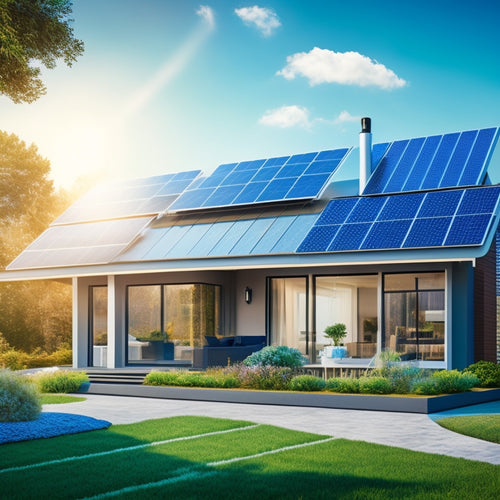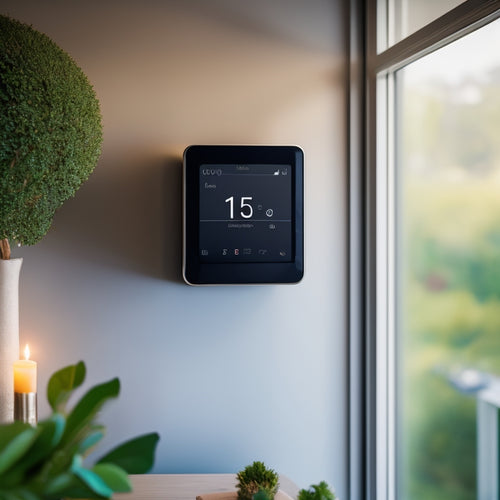
What Keeps Your Water Heater Running Smoothly?
Share
You can guarantee your water heater runs smoothly and efficiently by staying on top of routine maintenance tasks, such as regular system checks, heat exchanger inspections, and pressure relief valve maintenance, which can help prevent unexpected failures, costly repairs, and even safety hazards. Regularly inspect your water heater for signs of corrosion, rust, or mineral buildup, and address leaks and corrosion promptly. By following these steps, you'll be well on your way to extending the life of your water heater and avoiding common issues. Now, take a closer look at each of these essential tasks to optimize your water heater's performance.
Key Takeaways
- Regular system checks, including temperature and pressure relief valve inspections, prevent unexpected failures and costly repairs.
- Cleaning heat exchangers and removing sediment buildup ensures efficiency and safety, while also preventing premature failure.
- Pressure relief valve maintenance and testing prevents excessive pressure buildup, which can lead to explosions or leaks.
- Inspecting for leaks and corrosion, including rust spots and anode rod condition, helps identify potential issues before they escalate.
- Proper installation, temperature setting adjustments, and energy efficiency monitoring all contribute to a smoothly running water heater.
Regular System Checks
Every three months, take a few minutes to inspect your water heater's system.
Check the temperature and pressure relief valve to verify it's functioning correctly. Regularly inspecting cables for wear and tear, such as insulation damage, can also help prevent shocks and fires.
Look for signs of corrosion, rust, or mineral buildup on the tank and pipes. Make certain all connections are secure and not leaking.
This routine maintenance will help prevent unexpected failures and costly repairs. If you notice any issues, consider system upgrades, such as replacing old pipes or installing a new valve.
Regular checks will give you peace of mind and freedom from worrying about your water heater's performance. By staying on top of maintenance, you'll extend the lifespan of your water heater and avoid sudden, unwanted surprises.
Proper Installation Matters
By maintaining a regular system check routine, you'll be well-equipped to identify potential issues before they become major problems.
However, even the most diligent maintenance routine can't compensate for a poorly installed water heater. Proper installation is essential to guarantee your water heater runs efficiently and safely.
Shifting to renewable energy sources, such as solar power solutions, can also reduce carbon footprint and operating costs.
Different water heater types, such as conventional, tankless, and heat pump models, require specific installation techniques. For instance, conventional water heaters need to be levelled and securely fastened to the floor, while tankless models require precise piping and venting configurations.
Improper installation can lead to reduced performance, increased energy bills, and even safety hazards.
Verify your water heater is installed correctly to reap the benefits of a smooth-running system.
Cleaning the Collector Tubes
You'll need to clean the collector tubes regularly to guarantee your water heater operates at peak efficiency. The tubes, typically made of copper, stainless steel, or PEX, can accumulate dirt, debris, and mineral buildup, reducing heat transfer and overall performance.
Cleaning frequency depends on your water quality and usage; as a general rule, clean the tubes every 6-12 months. In addition to regular cleaning, incorporating solar-powered solutions can further reduce your carbon footprint and energy costs. Similarly, implementing energy storage systems can optimize energy usage and minimize grid reliance.
Use a soft-bristled brush or a tube cleaning brush to remove any debris or sediment. For more stubborn buildup, mix baking soda and vinegar to create a paste, and apply it to the affected area. Let it sit for 30 minutes before rinsing with warm water.
Regular cleaning guarantees your water heater runs smoothly, efficiently, and safely, giving you the freedom to enjoy a warm shower whenever you want.
Inspecting Heat Exchangers
You'll want to inspect your heat exchanger regularly to guarantee it's operating efficiently and safely.
Regular cleaning and maintenance practices like those for solar panels can help prevent dirt and debris buildup, enhancing energy efficiency.
Start by cleaning the heat exchanger to remove any debris or sediment that may be affecting performance.
Next, inspect the exchanger tubes for signs of damage, corrosion, or scale buildup, which can lead to reduced heat transfer and increased energy costs.
Heat Exchanger Cleaning
Every few years, sediment and mineral buildup can clog the heat exchanger, reducing your water heater's efficiency and eventually leading to premature failure.
You'll need to clean the heat exchanger to remove these deposits and maintain peak performance. Regular maintenance, including cleaning and inspecting connections, is essential for optimizing performance and guaranteeing longevity, as solar panel maintenance can prevent up to 20% efficiency loss.
The type of heat exchanger you have will determine the best cleaning method. For example, tube-and-shell heat exchangers made from copper or stainless steel can be cleaned with a descaling solution, while plate-and-frame heat exchangers made from titanium or other exotic materials may require a more gentle approach.
Be certain to consult your water heater's manual or manufacturer's instructions for specific guidance on cleaning and maintaining your heat exchanger.
Regular cleaning will help prevent clogs and guarantee your water heater runs smoothly and efficiently.
Exchanger Tube Inspection
Heat exchanger tubes are a critical component of your water heater's heat exchanger, responsible for transferring heat from the heating source to the water.
As you inspect the exchanger tubes, check for signs of corrosion, scaling, or damage. The exchanger tube materials, typically copper, stainless steel, or titanium, affect the tube's lifespan. A typical exchanger tube lifespan ranges from 10 to 20 years, depending on the material, water quality, and usage.
During inspection, look for leaks, rust, or mineral buildup, which can reduce the tube's efficiency and shorten its lifespan. Proper inspection and maintenance can extend the life of your water heater and guarantee it runs smoothly and efficiently.
Scale Buildup Prevention
As you've checked the exchanger tubes for signs of corrosion, scaling, or damage, it's now essential to focus on preventing scale buildup in the heat exchangers themselves.
Scale buildup occurs when mineral deposits from hard water settle on the exchanger's surface, reducing its efficiency. To prevent this, you can use scale inhibitors or chemical treatments that remove mineral deposits.
Regular flushing of the heat exchanger also helps remove sediment and debris. Additionally, guarantee good water quality by installing sediment traps and maintaining proper temperature regulation.
Tank insulation is also vital to prevent heat loss and reduce the risk of scaling. By performing preventive maintenance and addressing water hardness, you'll keep your water heater running smoothly and efficiently.
Pressure Relief Valve Maintenance
Your water heater's pressure relief valve is a vital safety component that prevents excessive pressure buildup, which can lead to catastrophic tank failure.
You should test the valve regularly to confirm it's functioning properly. To do this, locate the valve and lift the test lever - you should hear a gurgling sound as water flows out. If not, it may be stuck or faulty, and you'll need to replace it.
Valve replacement is a relatively simple process, but it's important to follow the manufacturer's instructions to avoid any mistakes.
Checking for Leaks and Corrosion
You'll want to regularly inspect the drain pan for signs of water accumulation or mineral buildup, which can indicate a leak.
Also, keep an eye out for rust spots on the tank or pipes, as these can be a sign of corrosion.
Additionally, you should check the anode rod's condition to verify it's not compromised, which could lead to accelerated corrosion and leaks.
Inspect Drain Pan Regularly
Regularly inspecting the drain pan is essential to preventing water damage and corrosion in your water heater.
You should check the drain pan's materials, such as plastic, metal, or concrete, for signs of corrosion or degradation.
Verify the drain pan is properly placed under the water heater to catch any leaks or condensation.
Improper drain pan placement can lead to water damage and corrosion.
You should also check the drain pan's connection to the water heater, making sure it's secure and watertight.
Look for Rust Spots
Many water heaters develop rust spots over time, which can be a sign of leaks or corrosion. To prevent rust from spreading, you should inspect your water heater regularly for any signs of rust or corrosion.
Look for rust spots on the tank, pipes, and fittings. Check for any water leaks or mineral deposits that can contribute to rust formation.
If you find rust spots, treat them promptly with a corrosion treatment to prevent further damage. Applying a rust prevention coating can also help protect your water heater from future rust formation.
Regular inspections and prompt treatment can help extend the life of your water heater and prevent costly repairs.
Check Anode Rod Condition
Corrosion protection is a vital aspect of water heater maintenance, and the anode rod plays an important role in this process.
You should regularly check the anode rod's condition to guarantee it's providing adequate corrosion resistance.
Inspect the rod for signs of wear, such as calcium carbonate buildup or corrosion. If you notice any of these signs, it's likely time for anode rod replacement.
Here are some key things to look for during inspection:
- Check the rod's length - if it's less than 1/2 inch, replace it
- Look for signs of corrosion, such as rust or pitting
- Check for calcium carbonate buildup, which can reduce the rod's effectiveness
Draining Sediment Buildup
Over time, sediment builds up at the bottom of your water heater, reducing its efficiency and potentially causing damage. You can prevent this by draining sediment buildup regularly. There are different types of sediment that can accumulate, including:
| Sediment Type | Description |
|---|---|
| Mineral deposits | Hard, white, or off-white substances formed from dissolved minerals in water |
| Rust and corrosion | Flakes of rust or corrosion from the tank or pipes |
| Debris | Dirt, sand, or other particles that enter the tank |
To determine the flushing frequency, consider the following factors:
| Factor | Flushing Frequency |
|---|---|
| Water hardness | Every 6-12 months in hard water areas, every 12-18 months in soft water areas |
| Water quality | Every 6-12 months if you notice sediment buildup or rusty water |
| Usage | Every 12-18 months for low-usage households, every 6-12 months for high-usage households |
Adjusting Temperature Settings
How efficiently does your water heater operate when it's not set to the ideal temperature? Adjusting the thermostat can have a significant temperature impact on your water heater's performance.
If the temperature is set too high, it can lead to scalding and energy waste. On the other hand, a temperature that's too low can result in lukewarm water.
Here are some key considerations when adjusting your temperature settings:
-
Energy Efficiency: Lowering the temperature can reduce energy consumption and save you money on your utility bills.
-
Scald Protection: Setting the temperature to 120°F (49°C) or lower can prevent scalding and reduce the risk of injury.
-
Water Quality: Adjusting the temperature can also affect the quality of your water, as certain temperatures can facilitate bacterial growth.
Monitoring Energy Efficiency
As you've optimized your temperature settings, it's time to focus on monitoring energy efficiency to guarantee your water heater operates at its best.
You can do this by tracking your energy consumption and identifying areas for efficiency upgrades. Analyze your usage patterns to determine when your water heater is working hardest, and adjust your maintenance schedule accordingly.
Regular performance monitoring will help you pinpoint opportunities for cost analysis and insulation improvements.
Consider investing in smart technology to streamline the process.
Frequently Asked Questions
How Often Should I Replace My Water Heater's Anode Rod?
You should replace your water heater's anode rod every 5-10 years, depending on usage and water quality, as part of regular anode rod maintenance to extend its lifespan and prevent corrosion, ensuring your heater runs efficiently and freely.
Can I Use a Water Heater With a Cracked or Broken Tank?
You shouldn't risk using a water heater with a cracked or broken tank, as it compromises water heater safety, leading to leaks and potential explosions; instead, investigate tank replacement options to guarantee a secure and efficient system.
Is It Necessary to Insulate My Outdoor Water Heater?
Wrap your outdoor water heater in a warm hug of insulation, and you'll be embracing energy efficiency, slashing your energy bills, and giving Mother Nature a high-five - it's a necessary step for a hassle-free, eco-friendly life.
Can I Install a Water Heater Myself, or Do I Need a Plumber?
You can attempt a DIY water heater installation, but it's essential you're comfortable with DIY plumbing and local building codes; if not, it's recommended you hire a licensed plumber to guarantee a safe and efficient installation.
Will a Water Heater Still Work if the Thermostat Is Faulty?
Like a conductor leading an orchestra, a thermostat harmonizes your water heater's performance, but if it's faulty, the show won't entirely stop - you'll still get hot water, albeit inefficiently; consider thermostat replacement to restore peak efficiency and avoid costly repairs down the line.
Related Posts
-

7 Best Cool Roof Rebates for Energy-Savvy Homeowners
You're an energy-savvy homeowner looking to install a cool roof, and you're wondering which rebates can help you save...
-

Smart Energy: Greener Homes With Connected Power Devices
You can control and optimize your energy consumption with smart energy devices, reducing your carbon footprint by up ...
-

3 Eco-Friendly Automated Blinds for Contemporary Living
You're looking to raise your living space with automated blinds that not only exude contemporary style but also align...


